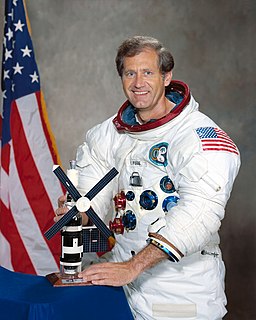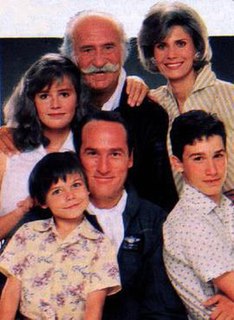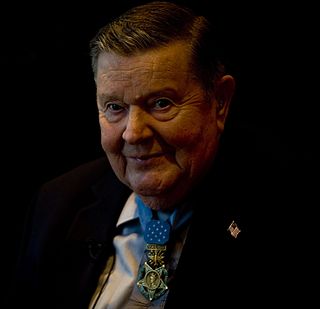
Joseph William Kittinger II is a retired colonel in the United States Air Force and a USAF Command Pilot. His initial operational assignment was in fighter aircraft, then he participated in Project Manhigh and Project Excelsior high altitude balloon flight projects from 1956 to 1960, setting a world record for the highest skydive from a height greater than 19 miles (31 km). He was also the first man to make a solo crossing of the Atlantic Ocean in a gas balloon, and the first man to fully witness the curvature of the earth.

The Doolittle Raid, also known as the Tokyo Raid, on Saturday, April 18, 1942, was an air raid by the United States on the Japanese capital Tokyo and other places on the island of Honshu during World War II, the first air operation to strike the Japanese Home Islands. It demonstrated that the Japanese mainland was vulnerable to American air attack, served as retaliation for the attack on Pearl Harbor, and provided an important boost to American morale. The raid was planned and led by Lieutenant Colonel James Doolittle of the United States Army Air Forces.

The USAF Air Demonstration Squadron ("Thunderbirds") is the air demonstration squadron of the United States Air Force (USAF). The Thunderbirds are assigned to the 57th Wing, and are based at Nellis Air Force Base, Nevada. Created 66 years ago in 1953, the USAF Thunderbirds are the third-oldest formal flying aerobatic team in the world, after the United States Navy Blue Angels formed in 1946 and the French Air Force Patrouille de France formed in 1931.

On 1 May 1960, a United States U-2 spy plane was shot down by the Soviet Air Defence Forces while performing photographic aerial reconnaissance deep into Soviet territory. The single-seat aircraft, flown by pilot Francis Gary Powers, was hit by an S-75 Dvina surface-to-air missile and crashed near Sverdlovsk. Powers parachuted safely and was captured.

Stuart Allen "Stu" Roosa, Col., USAF, was an American aeronautical engineer, United States Air Force pilot, test pilot, and NASA astronaut, who was the Command Module Pilot for the Apollo 14 mission. The mission lasted from January 31 to February 9, 1971 and was the third mission to land astronauts on the Moon. While Shepard and Mitchell spent two days on the lunar surface, Roosa conducted experiments from orbit in the Command Module Kitty Hawk. He was one of 24 men to travel to the Moon.

The Distinguished Flying Cross is a military decoration awarded to any officer or enlisted member of the United States Armed Forces who distinguishes himself in support of operations by "heroism or extraordinary achievement while participating in an aerial flight, subsequent to November 11, 1918."

Fred Wallace Haise Jr. is an American former NASA astronaut, fighter pilot with the U.S. Marine Corps and the U.S. Air Force and test pilot. He is one of only 24 people to have flown to the Moon, having flown as Lunar Module Pilot on Apollo 13. He was to have been the sixth person to land and walk on the Moon, but the Apollo 13 mission was aborted before lunar landing. He went on to fly Space Shuttle Approach and Landing Tests in 1977, and retired from NASA in 1979.

Loren James Shriver is a former NASA astronaut, aviator, and a retired US Air Force Colonel.

Karol Joseph "Bo" Bobko, , is an American aerospace engineer, retired U.S. Air Force officer, test pilot, and a former USAF and NASA astronaut. Bobko was the first graduate of the US Air Force Academy to travel in space.

Nancy Harkness Love, born Hannah Lincoln Harkness, was an American pilot and commander during World War II. She earned her pilots license at age 16. She worked as a test pilot and air racer in the 1930s. During World War II she convinced William H. Tunner to look to set up a group of female pilots to ferry aircraft from factories to air bases. This proposal was eventually approved as the Women's Auxiliary Ferrying Squadron. Love commanded this unit and later all ferrying operations in the newly formed Women Airforce Service Pilots. She was awarded the Air Medal for her work during the war and was appointed lieutenant colonel in the US Air Force Reserve in 1948.

William Reid Pogue, , was an American astronaut, U.S. Air Force fighter pilot, and test pilot who was also an accomplished teacher, public speaker and author.

Marine Helicopter Squadron One (HMX-1) is a United States Marine Corps helicopter squadron responsible for the transportation of the President of the United States, Vice President, Heads of States, DOD Officials and other VIPs as directed by the Marine Corps and White House Military Office (WHMO). A Marine helicopter which has the President aboard uses the call sign "Marine One". Previously, HMX-1 was also tasked with Operational Test and Evaluation (OT&E). This task was reassigned to VMX-1 in Yuma, Arizona; since the contract award of the new Presidential Helicopter in 2014 to Sikorsky Aircraft, however, HMX-1 has assumed the temporary role of OT&E for this platform, due to its unique nature and mission. The VH-92A achieved first flight in 2017 and is expected to be operational in 2020. Nicknamed "Nighthawks", they are headquartered at Marine Corps Air Facility Quantico, Virginia, and maintain detachments at Joint Base Anacostia–Bolling in Washington, D.C. and Joint Base Andrews Naval Air Facility in Maryland.

William John "Pete" Knight was an American aeronautical engineer, politician, Vietnam War combat pilot, test pilot, and astronaut. He was one of twelve pilots who flew the North American X-15, an experimental spaceplane jointly operated by the Air Force and NASA. He was also selected for participation in the X-20 Dyna-Soar program.

Call to Glory was an American drama that aired for 22 episodes during the 1984–1985 TV season on the ABC network.

The Aeronautical Division, Signal Corps (1907–1914) was the first heavier-than-air military aviation organization in history and the progenitor of the United States Air Force. A component of the U.S. Army Signal Corps, the Aeronautical Division procured the first powered military aircraft in 1909, created schools to train its aviators, and initiated a rating system for pilot qualifications. It organized and deployed the first permanent American aviation unit, the 1st Aero Squadron, in 1913. The Aeronautical Division trained 51 officers and 2 enlisted men as pilots, and incurred 13 fatalities in air crashes. During this period, the Aeronautical Division had 29 factory-built aircraft in its inventory, built a 30th from spare parts, and leased a civilian airplane for a short period in 1911.

Joe Madison Jackson served as a career officer in the United States Air Force and received the Medal of Honor for heroism above and beyond the call of duty during the Vietnam War. On 12 May 1968, he volunteered for a dangerous impromptu rescue of three remaining Air Force members trapped at an overrun Army Special Forces camp. While the camp was still under heavy enemy fire from North Vietnamese and Viet Cong troops, he skillfully piloted his C-123 cargo plane and rescued the three men.

Lt. Col. Alexander Jefferson is a retired US Air Force officer, famous as one of the Tuskegee Airmen, the 332nd Fighter Group.

William Atkinson Jones III was a United States Air Force officer and a recipient of the United States military's highest decoration—the Medal of Honor—for his actions in the Vietnam War.

William G. Draper was a career military officer and Air Force Aide to President Dwight D. Eisenhower.
























